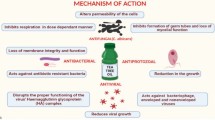Abstract
Data sources
Medline, Embase, LILACS and Scopus database.
Study selection
Studies were screened independently by three reviewers. Randomised controlled trials with a minimum of six months follow-up of daily use of essential oils-containing (EO) mouthwashes compared with placebo, flossing or cetylpyridinium chloride (CPC) as adjuncts to mechanical plaque control were considered.
Data extraction and synthesis
Data were abstracted by two reviewers and study quality assessed using the Cochrane risk of bias tool. Dental plaque was summarised using the Turesky modification of the Quigley-Hein Index (QHI), gingivitis using three indices; the Gingival Index (GI) by Loe and Silness, the Modified Gingival Index (MGI) and bleeding upon probing. Mean and standard deviations were reported and meta-analysis conducted. Sources of effect modification were investigated using meta-regression.
Results
Sixteen trials were included involving 4016 patients in total. Study quality was considered to be moderate to low. Compared with placebo meta-analysis of 14 studies showed statistically significant differences in favour of EO mouthwashes for plaque and gingival indices. Meta-analysis of four studies also demonstrated statistically lower levels of plaque and gingivitis for EO mouthwashes compared with cetylpyridium chloride (CPC). Meta-regression indicated that heterogeneity observed in plaque scores was mainly explained by the percentage of males in a trial and supervision of the mouthwash use.
Conclusions
In patients with gingivitis, EO-containing mouthwashes are more efficacious for the reduction of plaque and gingival inflammation than mechanical plaque control either alone (placebo) or in combination with mouthwashes with CPC. The expected benefits may be clinically relevant and may be also observed in the interproximal area.
Similar content being viewed by others
Commentary
Mouthwashes or rinses have been used for centuries, but it is only in the last 50–60 years that carefully formulated and tested commercial products have become widely available. The aim of this review was to assesses the effectiveness of one group of mouthwashes, those containing essential oils, in reducing plaque levels when used as an adjunct to mechanical plaque control.
The authors have searched a good range of databases with no restrictions on language or date of publication. Good methodological approaches were used for the selection, data abstraction and quality assessment of the included studies; only studies with a minimum of six months' duration being included. Plaque and gingivitis scores were the main outcomes considered. One hundred and seven potentially relevant studies were identified with a large proportion (39) being excluded because they were shorter than six months in duration. All the included studies were industry funded and testing Listerine® products. Assessment of study quality suggests that around half of the studies were at low risk for random sequence generation but there was less clarity on allocation concealment. However, only one of the included studies was unclear regarding blinding of the outcome assessors. This led the authors to conclude that the quality of the overall body of evidence was moderate to low.
All the included studies showed a statistically significant reduction in plaque for EO mouthwashes compared to placebo. A number of meta-analyses were conducted, for the Quigly-Hine Index the weighted mean difference (WMD) in favour of EO mouthwashes = −0.86 (95%CI; −1.05 to −0.66). EO mouthwashes were also more effective than placebo for all the gingival indices. This equates to a 32% reduction in plaque and a 24% improvement in modified gingival index. The meta-analyses demonstrated a high degree of heterogeneity and the authors investigated this using meta-regressions which suggest that much of the heterogeneity in the plaque scores could be explained by the percentage of males in the studies and whether the mouthwash use was supervised. For the gingival indices the provision of oral hygiene was a major contributor.
A 2015 meta-analysis by Araujo et al.1 also investigated the effect of EO mouthwashes on plaque and gingivitis. That review included 29 industry sponsored trials of six months or longer, 11 of which were unpublished. They calculated summary percentage reductions in whole-mouth mean plaque of 27.7% (95%CI; 22.4–32.9) and gingivitis of 16.0% (95%CI; 11.3–20.7) respectively. Four studies involving a total of 982 patients compared EO and CPC mouthwash with analysis indicating lower levels of plaque and gingivitis with EO mouthwashes.
While the Araujo review and this new review demonstrate a statistically significant improvement in plaque and gingivitis scores, the clinical importance of the findings is more difficult to assess. The review does not consider adverse effects. Most of the included studies are assessed against placebo so more head-to-head studies against other mouthwashes and other agents to improve oral heath are needed. For example a 2012 meta-analysis of chlorhexidine mouthrinse2 found that its use reduced plaque by 33% and gingivitis by 26%, and a 2013 Cochrane review by Riley and Lamont3 demonstrated a 42% reduction in plaque severity and 48% reduction in bleeding with triclosan/copolymer toothpaste use. However, the limited direct comparisons, both in terms of effectiveness and cost-effectiveness and knowledge of any potential adverse effects, make it difficult to recommend the most appropriate regimens for patients.
References
Araujo MW, Charles CA, Weinstein RB, et al. Meta-analysis of the effect of an essential oil-containing mouthrinse on gingivitis and plaque. J Am Dent Assoc 2015; 146:610–622.
Van Strydonck DA, Slot DE, Van der Velden U, Van der Weijden F . Effect of a chlorhexidine mouthrinse on plaque, gingival inflammation and staining in gingivitis patients: a systematic review. J Clin Periodontol 2012; 39:1042–1055.
Riley P, Lamont T . Triclosan/copolymer containing toothpastes for oral health. Cochrane Database Syst Rev 2013; 12: Art. No. CD010514.
Author information
Authors and Affiliations
Additional information
Address for correspondence: Alex N Haas, Rua Ramiro Barcelos, 2492 – Periodontia – Bom Fim, 90030–035, Porto Alegre–RS, Brazil. E-mail: alexnhaas@gmail.com
Haas AN, Wagner TP, Muniz FW, Fiorini T, Cavagni J, Celeste RK. Essential oils-containing mouthwashes for gingivitis and plaque: Meta-analyses and meta-regression. J Dent 2016; 55: 7–15.
Rights and permissions
About this article
Cite this article
Richards, D. Effect of essential oil mouthwashes on plaque and gingivitis. Evid Based Dent 18, 39–40 (2017). https://doi.org/10.1038/sj.ebd.6401233
Published:
Issue Date:
DOI: https://doi.org/10.1038/sj.ebd.6401233



